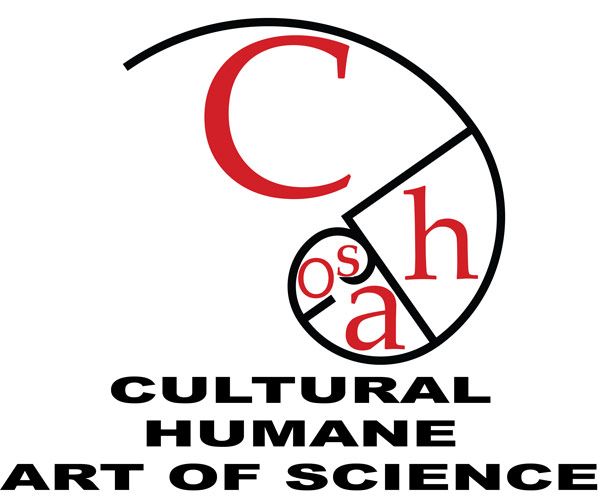Here I present action research of my team and me that is relevant to this PhD position and focused on ‘Sustainability of Digitalisation’ and ‘Digitalisation of Sustainability’.
Several workshops, experiments, and projects are described, that will continue similarly to support evaluation and diffusion of our future research.
This list of use cases is in addition to the public record of our activities/projects in the area of sustainable development, available here: https://cha-os.org/en/sustainable-development/
By performing such community research and practice, I developed most of the 18 core competencies that make us uniquely suited to address complex questions of action research, participatory design, and community practice (Dalton & Wolfe, 2012).
The technological know-how, UI design, and more from my IT-background can be assessed through my open source contributions to the code at https://github.com/Cha-OS/colabo
IMPORTANT DON'T MOVE THIS - IT'S placeholder FOR A TOCFirst of the use cases in the list is designing a DialoGame method for gamified dialogues, through a series of participatory design workshops. DialoGame itself was afterward used as a method in several other use cases.
DialoGame
DialoGame is a structured, dynamic and low-friction method designed for conducting dialogue across and among disciplines. It provides a gamified environment for focused discussion and knowledge extraction. By this gamified approach, we seek to empower, motivate and educate efficient behaviors in dialogues.
The DialoGame format is based on the usage of physical artifacts like talkens (talking tokens), activity cards, creative cards, visualization, but also interactive socio-technical components like ColaboWare HCI (human-computer interfaces) as RFID cards, remote controllers, touch screens. It is augmented and visualized by interactive online mapping tools (KnAllEdge maps, RIMA and several other modules of Colabo.Space).
More info and illustrations at https://cha-os.org/en/dialogame/
Business Angelina - Sustainable Entrepreneurship
Sustainable Development inspiring Business
ChaOS/ReTesla team trained for 2 days female entrepreneurs and those that wanted to become ones.
Participants used our mobile app NCA for networking on shared goals for collective problem-solving. They were inspired and trained to model their business ideas toward sustainability - to consider Sustainable Development (Goals) - to connect their business with their inner vision and passion, in order to support crowdfunding, international funds and motivation for volunteers, and to bring social good.
Research Findings from Business Angelina: SUS evaluation (Brooke, 1996): 73.75; (very) good. CSI evaluation (Carroll et al., 2009) excellent: 86.4 / 100.
More info and photo at https://cha-os.org/en/sustainable-development/#business_ang
Colabo.Space
Colabo.Space is as an ecosystem for a collective mind, where the notion of a collective mind represents the model of collectiveness, its interactions across, and improvements of a community.
A great deal of our work with Colabo.Space aligns with the Computer-Supported Cooperative Work (CSCW) research field. It seems that CSCW has two different roles (of our interest, among many) - 1) observatory role - understanding CSCW phenomena (referring to the type of work CSCW as a scientific field is interested in), and 2) guidance role CSCW and design of computer systems, guided with CSCW findings and foundation.
Computer-Supported Cooperative Work (CSCW)
In our understanding, CSCW did not manage to govern the design and development of cyberinfrastructure, to introduce practices, policies, and heuristics that would support the healthy development of cyberinfrastructure, supporting both its infrastructure and organization needs, as well as the requirements of each actant (~ actor) in the system, and focus on reducing the socio-technical gap. Cyberinfrastructure is left at the mercy of non-domain IT experts, investors, businesses and communities that try to “reprogram” their patterns according to system capabilities and functionalities. In an adjacent field, Human-Computer Interaction (HCI) managed to establish more rigid mechanisms of evaluation and provided quick and dirty evaluation heuristics (Nielsen, 1994; Gerhardt‐Powals, 1996; Weinschenk & Barker, 2000).
Through our work on Colabo.Space, we are aiming to strengthen an unfulfilled (in our opinion) role of the CSCW, the guidance role and, in such a way, to promote positive system design patterns.
Activity Theory, Actor-Network Theory, BPMN and ColaboFlow
In our research, we drew a great deal of our inspiration from the CSCW "observatory role" research corpus; Activity Theory (AT) (Leont'ev, 1974), Actor-Network Theory (ANT) (Latour, B. 1996), dynamic theory of work (Bardram, 1998), boundary object (Star & Griesemer, 1989), awareness, etc.).
Cognitive load theory
(Reis, 2018) shows that the most dominant emotions in the CSCL (Computer-Supported Collaborative Learning) systems are fear and frustration. It should make sense to extrapolate this finding to any Computer-Supported system. In our collective systems design and implementation, we are aware of this fact, and we aim to reduce frictions and cognitive load. The Cognitive load theory (Sweller, 1988) introduces and recognizes three types of cognitive load:
- intrinsic cognitive load - the effort associated with a specific tasks demand/complexity,
- extraneous cognitive load - the effort related to the process of resolving tasks (coming from the task performance methodology and tools) and
- germane cognitive load - the effort put into creating cognitive representations of acquired knowledge, or a schema
More on our approach toward this and more about Colabo.Space related research at https://cha-os.org/en/colabo-space-research/
2nd International Congress Nikola Tesla – Disruptive innovation
Sava Center, Belgrade, 2 – 4 June 2017
(Christensen, C. M., Raynor, M. E., & McDonald, R. (2015). What is disruptive innovation. Harvard Business Review, 93(12), 44-53.)
As an Organizing Committee Vice-chair of the http://www.tesla2017.com/ I have overseen and co-created both idea and the program of it http://en.tesla2017.com/scientific-program-2/
The congress program is dedicated to one of the most disrupting innovators of the XX century, Nikola Tesla[1], whose most of the ideas were ahead of time, starting to influence the industry in the late XX and even XXI century.
The keynote speeches were given by Prof. Dr. Garry Jacobs (US) (WAAS[2] president) – Towards Future Global Education; Prof. Dr. Mila Popović (US) – Tesla’s Anticipation as Prototype Of Scientific and Social Probing of Future; Prof. Dr. Bojana Škorc (RS) – Creativity in the World of Knowledge.
We hosted ‘Invited Panel – Towards WAAS Future Education Conference’.
I was also a moderator of 3 workshops
Workshop 1 – Tesla’s Inspired Holistic Questions of Creativity & Education
Workshop 2 – Tesla’s Inspired Holistic Questions of Psychosomatics & Spirituality
I would highlight the 3rd workshop:
Multidisciplinary Workshop 3 – ReMaking Tesla – Practices that Make a Genius
where we managed to gather scientists, writers, artists, as well as psychologists, yoga instructors and other specialists to co-create crossing multidisciplinary barriers and co-inspiring each other, by using DialoGame model. During this interactive event, they influenced each other to a Tesla-like mode of collective creative thinking.
ReMaking Tesla, Forum of Innovation
As a co-organizer of this forum that focuses on disruptive, innovative aspects of education, its IT-augmentation, digitalization of education, its interactivity, I focus on fostering of collective creativity and innovation capabilities through “the innovation of education and education of innovation”.
Tesla had a strong vision of how to change the world and society and increase technological capital to improve humanity. What are the values and visions, patterns, skills and behaviors that make a genius, as Tesla? How, based on this, can individuals and teams increase their innovation, creativity and complex problems solving capabilities? International transdisciplinary experts are discussing and teaching these approaches, novel education, socio-technical ecosystems and cyber-infrastructure for collaboration and collective intelligence, to empower participants on the way of remaking a (collective) genius.
Digitalization of City Game
City Game is an Educative Model-based game, having elements of a gamified Future Workshop (FW) especially the Fantasy phase (Vidal, 2006) and other Futures techniques, and goes well along with Transition Design (TD) approaches (Irwin, 2015, August). City game develops the skill of forecasting - as a process of making predictions of the future based on past and present data and by analysis of trends.
It is aimed to develop an awareness of problems, sustainability balance between different visions of future and resolution first through competence, and eventually aiming for cooperation and coevolution. City Game gamifies living simulation of the desired future, inspiring socio-technical fantasy, according to the chosen set of developmental trends (that were created through the previous series of Rapid Foresight sessions). By this, it successfully addresses a set of FW problems and limitations, especially ‘the effects of creative tools’ (Vidal, 2006).
Our team was invited to augment the game and provide technical mechanisms for tracking, evaluating and reflecting the progress in the game and between teams, through Colabo.Space IT ecosystem. We have used CoEvoLudens framework to achieve that goal and provide team members with digitized insights (with special care to not introduce digital friction).
More info and photo at https://cha-os.org/en/city-game/
ColaboWare HCI
CoLaboWare (CW) is our more in-depth endeavor into the field of Human-computer interaction and Interaction Design.
CW is a hardware UI (HCI) that reduces friction between social and technical components of a system and aids in the full integration of socio-technical (collaborative) processes.
It brings the power of the IT augmentation into social interaction while keeping a joy of human to human interaction. It is a missing puzzle in socio-technical ecosystems, that has a power of eliminating frictions that disabled IT-augmentation systems coming into full power and usage.
More info and photo at https://cha-os.org/en/colaboware/
Redesigning Journalism
Our intervention in the journalism space is, we believe, as important as our interventions in education, research and democracy spaces. Why? In the past, journalism was "invented" to disseminate news, opinions, inform society. In the middle of the 20th century, its mission was re-established by BBC as "responsible and truthful informer of society." Though recently we have been witnessing an increased information overload and focus on populistic news, it does not reduce its primary role as critical infrastructure for informing society.
We had a few interventions on the redesign of journalism. The first happened in Barcelona where the Knowledge Federation experts met with local journalists and tried to redesign journalism into more independent and sustainable practice that will not depend on sponsoring and needs for publishing popularist stories to compete with audience attention.
The second intervention happened in Siberia as a part of a Mediapolygon event for practicing journalism with experts on real problems and stories that occurs over hundreds of "spots" in a city during 24 hours. The whole event includes courses and reflections a few days around the day of practice. Our intervention was to integrate CoLaboArthon as a mechanism for closing the emotional loop with society and disseminating the journalistic stories internationally. We connected journalists and their stories with international artists, poets, and musicians.
The third intervention relates to the same Mediapolygon event, but there we focused on designing the process of journalism as an interactive process of creating and evolving social objects (or transactional object) and understanding how we can improve that process.
More info and photos at https://cha-os.org/en/redesigning-journalism/
Digitalization of Metaversity Education Processes
Metaversity is a “competency-based educational ecosystem” developed by our Russian partners Soling and EShcER. The system supports University and life-long learning. It is capable of describing different positions/professions in a particular field of interest. Each position is described through competencies that a student has to acquire or extend to “achieve” the particular position. The process of developing a required competence is through participation in relevant events with one of the possible roles that the event allows. Each role has a particular “footprint” on the competencies they develop. Teacher evaluates students performance through the role, and in such way recognize student’s progress in building her/his profession; presented on their professiogram (fig. metaversity-educational-model).
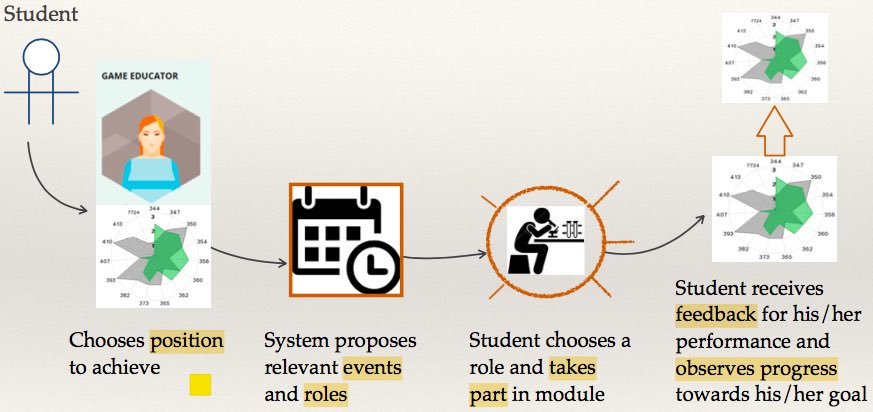
Figure metaversity-educational-model: Model of education through the Metaversity educational ecosystem
Our research contributes to the Metaversity educational ecosystem is in 3 domains.
Educational flows - we are researching on a solution for describing educational flows that student follows to reach the preferred profession. Without flow guidance, it is difficult for students to understand their position, direction, benefits, and which direction is the most optimal for their future studying. With the support of ColaboFlow we can visualize paths, compare them, match best options and combining it with RIMA component we can provide cross-student matchings, interest-based co-studying, and reflections of progress.
Face-to-virtual events - We are working on integrating CoEvoLudens methodology in the Metaversity ecosystem to reduce face-to-virtual friction, to help both with improving the interaction between face-to-face and virtual aspects of the event, but also to support the way of collecting data, students interactions and performance outcomes from the events they are participating.
EvoLuation - Finally with the support of the Colabo.ReM methodology we are able to evaluate the students’ progress, automate evaluation and offload teachers (bringing additional benefit for educational institutions in integrating Metaversity). As Colabo.ReM is aligned with ColaboFlow, we will be able to track the educational flow and improve it, providing in such way evaluative evolution - EvoLuation.
Innovation of the Higher Education in India
During the year 2016, we were part of the team that worked on innovation and redesigning of high education practice with multicultural aspects, being focused on the high education sector of India. The process was executed through international participatory (re-)design efforts by ProtopiaLabs team and performed and presented on India University as well as the traditional FICCI Higher Education Summit https://www.ficci-hes.com. We demonstrated methodological and technological augmentation of the interactive education processes by Colabo.Space.
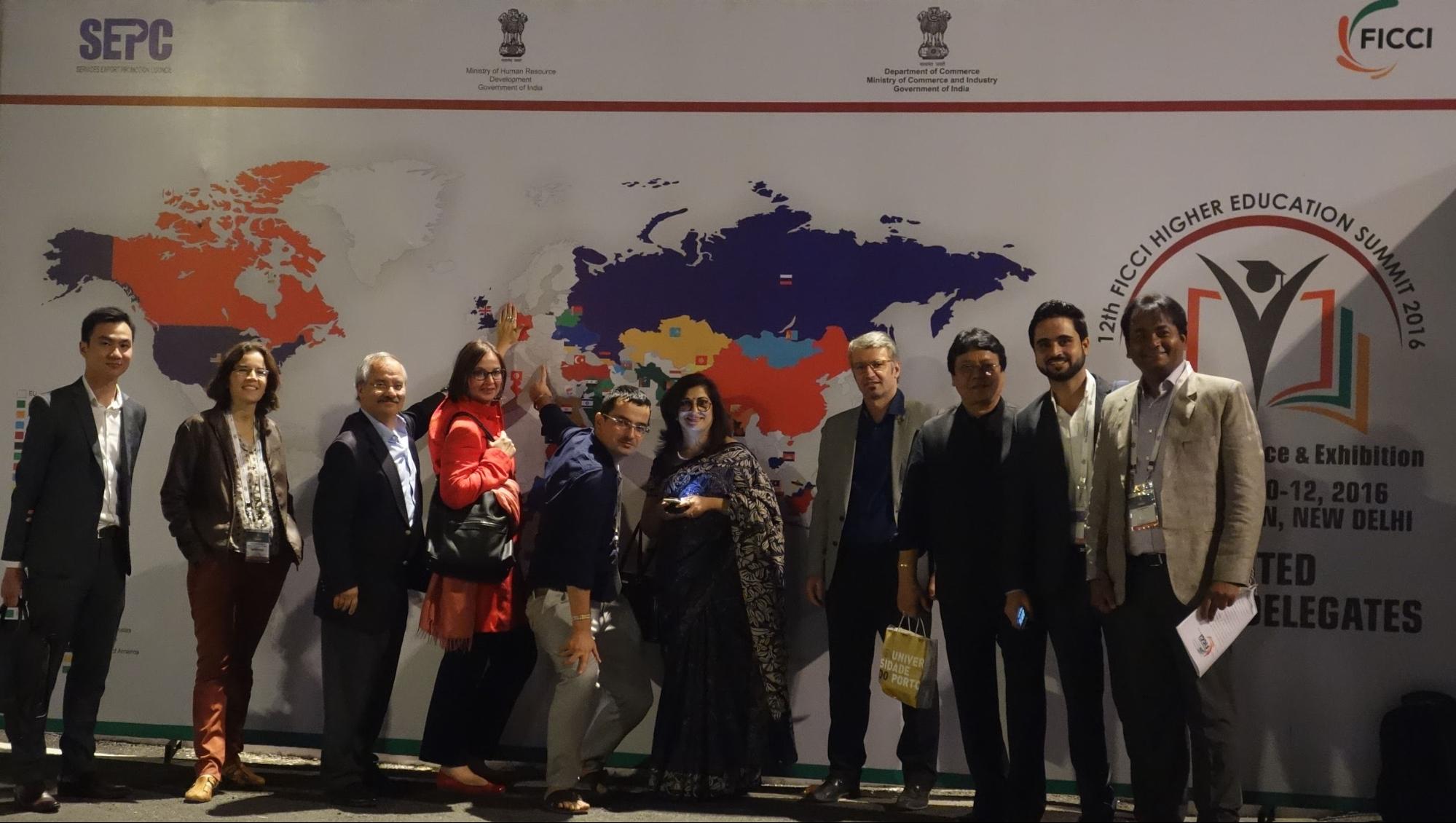

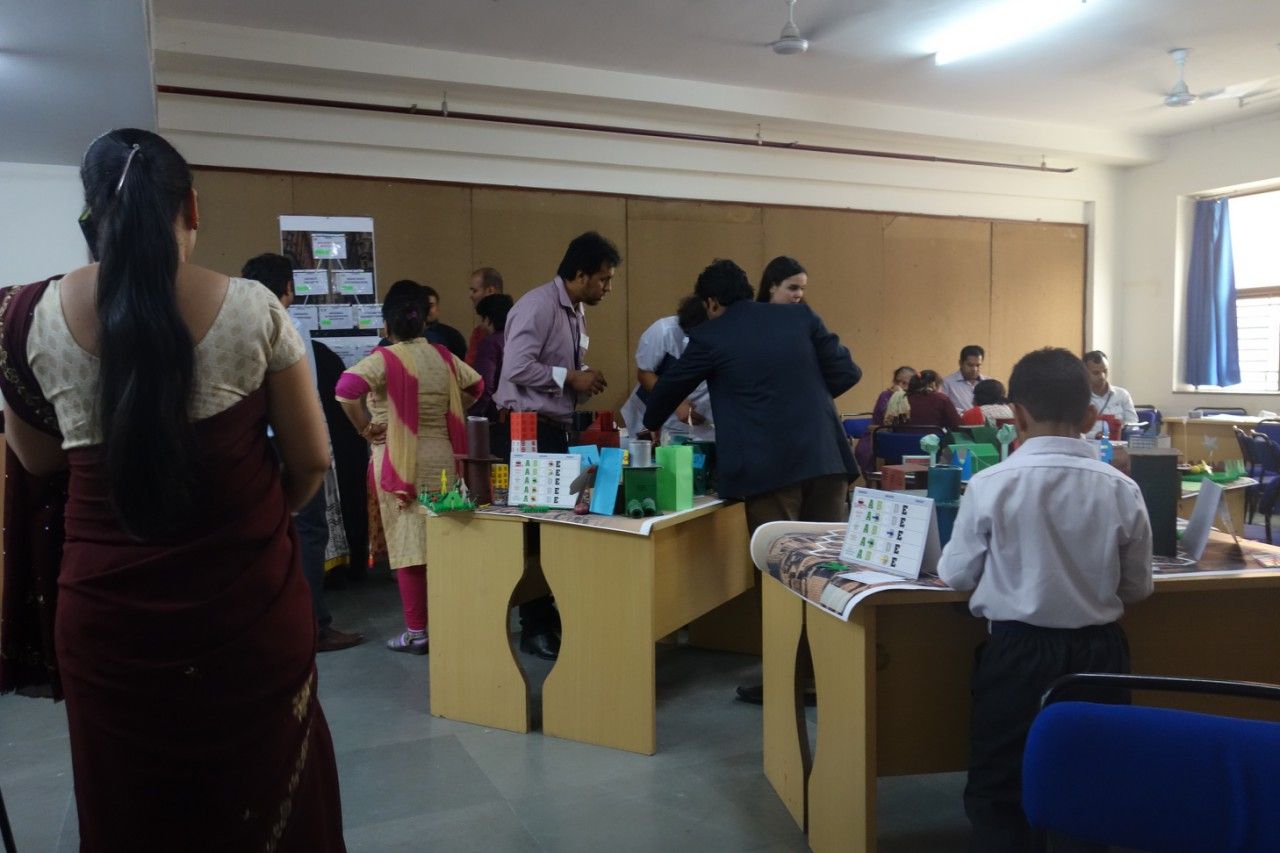
Everyday Heroes, Digitalization and Sustainability of civil courage
Dresden, Germany
ERASMUS+ project
https://www.jkpev.de/en/portfolio_page/everyday-heroes-2018
Civil courage training
ChaOS/ReMaking executed the training as a partner of www.jkpev.de for participants from Albania, the Czech Republic, Cyprus, Denmark, the former Yugoslav Republic of Macedonia, France, Germany, Greece, Hungary, Poland, Serbia, Slovakia, Spain, and the United Kingdom.
We organized the training according to our approach to intrinsic goals-driven civil courage and our approach to sustainable collective activism, socially engaged art, all based on SDGs.
The training is valuable as we designed a unique flow that is augmented with CoEvoLudens and supported with various methodologies: NCA, Performative Dialogue - from Goals to Action, ICT (Boyatzis, 2006), coaching with compassion (Boyatzis et al., 2006), collective performance, and gamification tools. We practiced various face-to-virtual activities and worked on creativity loops together with scholars of art. Eventually, we were able to evaluate the results of creativity support of our training.
More details, flow visualization, and creativity support results at: https://cha-os.org/en/everyday-heroes/
Un/Balancing complex systems: How to build thriving knowledge communities?
BunB Conference, 2016, Manizales, Colombia
Transdisciplinary workshop “Un/Balancing complex systems: Which data to look for? How to build thriving knowledge communities?” Ramon Sangüesa, Paz Tornero, Stella Veciana, Dino Karabeg, Sasha Rudan, Sinisa Rudan, BunB’16, Manizales, Colombia, 2016
Balance-Unbalance (BunB) is an annual International Conference designed around art and design as catalysts to explore intersections between nature, science, technology, and society. Every year, the focus is on one or more major current challenges surrounding the ecological crisis and discipline-transcending cooperation. The Balance-Unbalance conference brings together artists, designers, scientists, economists, philosophers, politicians, policymakers, sociologists, entrepreneurs and technologists from the world, based on the conviction that greater ecological awareness can be created through joint efforts. The conference focuses on debate, new insights and finding innovative solutions for issues arising from the global climate crisis.

Our participatory action research was performed on the topic of finding sustainability, a balance of opposing approaches of economic development (oil extraction) versus environmental preservation (Amazon forests), and socio-cultural preserving tribes lifestyle. My action research team and I gave a presentation, designed and executed a workshop about shared knowledge creation and co-creative dialogue on the above topic, working closely on the issue of the Yasuni National Park (Ecuador) - Yasuní-ITT Initiative. The transdisciplinary dialogue was performed through (and augmented by) Colabo.Space, with participants interacting both face-to-face and online.
It was followed by literature research (and exploration through artifacts in Museo del Oro, Bogota) on pre-Colombian indigenous approaches toward sustainability (with focus on Muisca and Tairona culture), a research on the role of shamans in balancing the ecosystem and returning the Earth in balance, after human unbalancing interventions.
It continued through light field research in Sierra Nevada de Santa Marta mountains (Tayrona National Natural Park), where still live Kogi_people, descendants of the Tairona culture, with rich shamanic tradition.
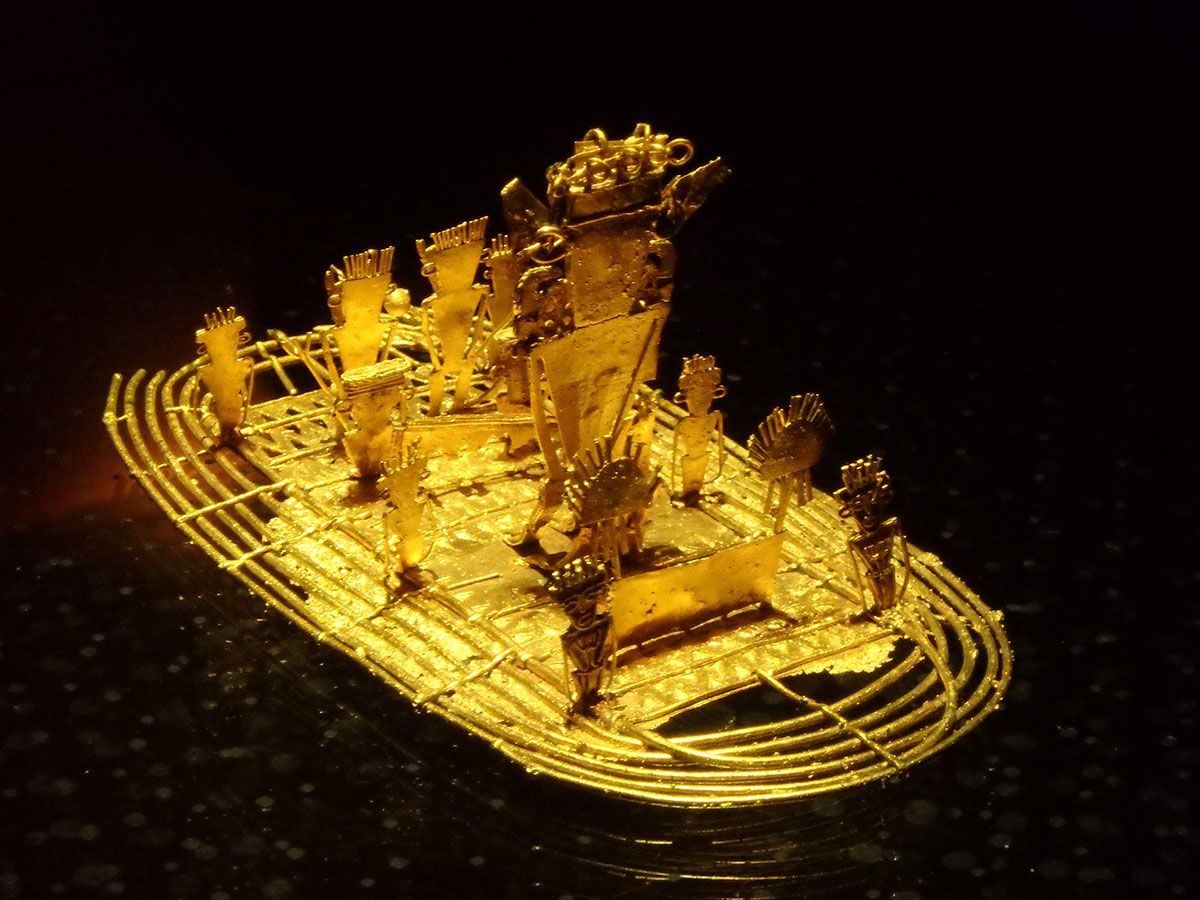
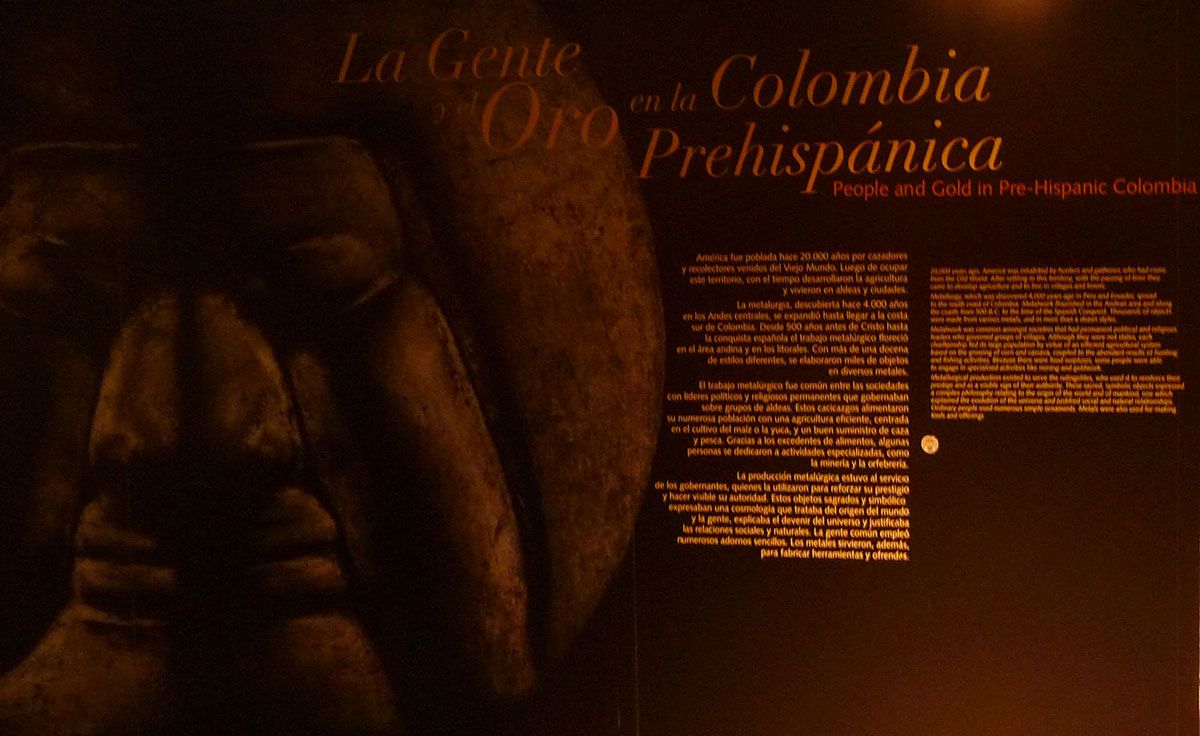

CoLaboArthon. Community Research and Action
CoLaboArthon is an ecosystem of methodologies and supportive IT tools. It is a novel model of a rapid, but highly energized process of collaborative research and co-creation between (socially engaged) art and science, between cognitive and emotional, often toward ideas generation addressing complex and wicked problems.
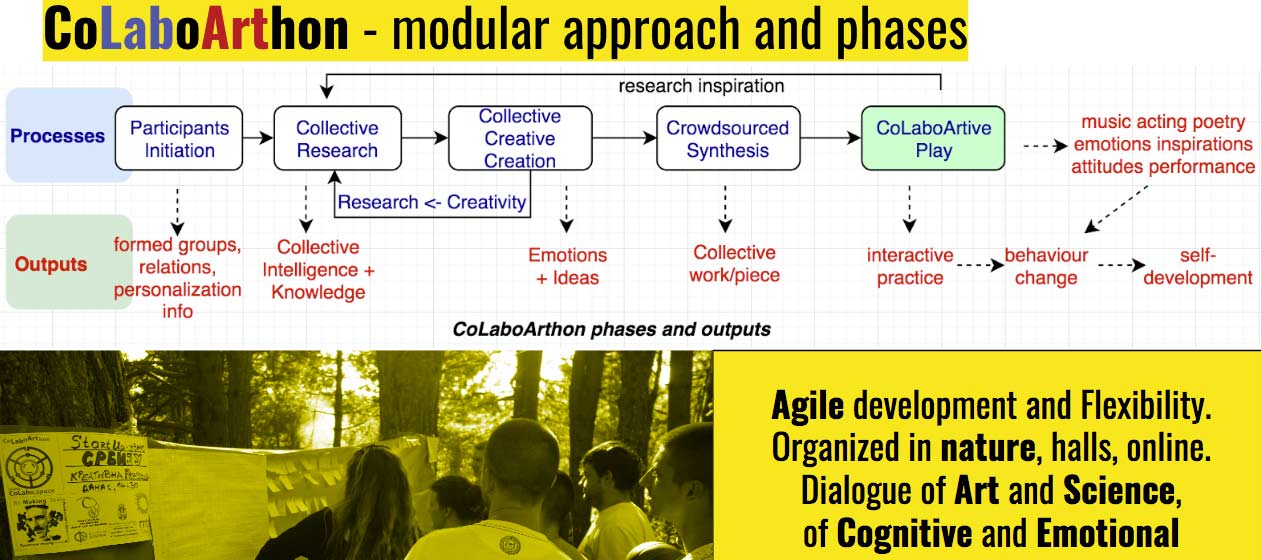
Employing CoLaboArthon we explore what an individual, untrained in the art can achieve if put in an environment that supports creative processes. We examine the catalysts for collective creativity. CoLaboArthon aims to enable Social Change, Individual and Collective Development among communities, that DON’T have access to trained facilitators. It researches possibilities for art, cultural heritage to penetrate in broader communities, to support social mobility in art. It leads to the Embodiment of the culture (Csordas et al., 1994).
CoLaboArthon and projects developed on top of it are supported by Ministry of Culture and Information (Serbia) and gathered the international consortium of partners and experts
Its development is being built on values guiding community research and action (Fawcett, 1991).

CoLaboArthon is selected to be presented at the ELO2019 conference in Ireland. A particular focus will be put on a dialogue of awarded international writers and communities over humane and touching topics inspired by Sustainable Development Goals.
During the recent instance, organized at Performing The World conference, we researched embodiment of SDGs through collective performance, and we had the opportunity to work with and be inspired by Patch Adams and his ongoing work on sustainability and global warming. (more about the PTW workshop and photos at: https://cha-os.org/en/sustainable-development/#ptw)
We develop a collective "zone of proximal development" for students to experience new knowledge through problem-solving and exploratory learning, driven by “In play a child always behaves beyond his average age, above his daily behavior. In play it is as though he were a head taller than himself.” Lev Vygotsky (Newman & Holzman, 2013).
We build social objects of poetry, memory, culture, theatre, and music. They are seeded and evolve in a crowdsourced manner through our socio-technical ecosystem. During the project’s journey across cultural and linguistic borders, we use NLP, machine-learning, automatic tools that we aim to extend with interlinear translation and other techniques for cross-matching textual artifacts and ultimately augment with sound and visual material. Finally, this interactive creation enables us to incorporate the audience into the dialogue.
More info and photos about ColaboArthon at https://cha-os.org/en/colaboarthon/
(Inter-)Cultural Sustainability. Unity out of Diversity
Among Four Pillars of Sustainable Development Cultural, Social, Environmental, Economical) (Fien, 2004; and others), we address cultural one through a set of Participatory Design and Action Research (Foth & Axup, 2006).
I’m especially interested and trained (by being a poet and cultural worker) in Intangible Cultural Heritage (ICH), and in effects (including globalization and multiculturalism) influencing their protection/destruction. Additionally, ICH is recognized as “a source of Human Creativity“ (UNESCO, 2003) and I see it as an alphabet of cultural/emotional/artistic co-creation/dialogue and a necessary ingredient of creative solutions in design.
I have designed and executed several face-to-face + virtual workshops and collaborations in our form of CoLaboArthon that practiced and developed multiculturalism, with one of the most compelling being Poetry on the Road, with 50+ poets writing in 10 languages. The polyglotism, speaking and writing poetry in several languages, helped me in managing these processes.
http://colabo.space/colaboarthon/poetry_on_the_road/
A research paper on the topic:
Sinisha Rudan, Sasha Rudan, Lazar Kovacevic, Eugenia Kelbert, Bob Holman, “Poetry on the Road: An Intercultural And Multidisciplinary IT-Augmented Dialogue on the Topic of Refugees and Migrants”, Comparing e/migrations: Tradition – (Post)memory – Translingualism (2019), Toruń.
Unifying Diversity
A series of our research is focused on building collective creativity out of diversity. Our workshops research intercultural aspects and storytelling approaches, being organized in India, around Europe, US.
Auroville is the world's first and only internationally endorsed experiment in human unity (UNESCO has endorsed the goals, plans and the direction of Auroville). It is a city where “individuals of great diversity would live in pursuit of human unity”. It is being researched through multiple papers as an ongoing prototype. It is thus, naturally that we are already designing action research to be performed at this living lab of multiculturality and unifying diversity.

As part of these action research efforts, we organized PPLG workshop, built on Nonviolent Communication by Marshall Rosenberg, HCI ColaboWare technology for team building through storytelling, and unity out of diversity views on the topic of migrations and refugees.
Participatory re-Design toward sustainability and digitalization
Sustainable Innovation through Collaborative Design
Jointly, with a local student organization (designers of Formula student and other mechanical engineering projects) I am designing workshops that would research and train innovation of the design and modeling toward sustainability and digitalization. The plan is to explore the organization’s processes - how to crowdsource them and make more collaborative.
It would be accompanied by a survey on challenges vs benefits for their process regarding their digitalisation, and enriching with sustainable vision/requirements. It is also accompanied by a lecture on sustainable development (SDGs) and a lecture about Collective Intelligence/Creativity/Innovation.
More on sustainable development ...
This list of use cases is in addition to the public list of our activities/projects in the area of sustainable development, available here: https://cha-os.org/en/sustainable-development/
References
- Bangor, A., Kortum, P., & Miller, J. (2009). Determining what individual SUS scores mean: Adding an adjective rating scale. Journal of usability studies, 4(3), 114-123.
- Bardram, J. (1998). Designing for the dynamics of cooperative work activities. DAIMI Report Series, 27(536).
- Boyatzis, R. E. (2006). An overview of intentional change from a complexity perspective. Journal of management development, 25(7), 607-623.
- Boyatzis, R. E., Smith, M. L., & Blaize, N. (2006). Developing sustainable leaders through coaching and compassion. Academy of Management Learning & Education, 5(1), 8-24.
- Brooke, J. (1996). SUS-A quick and dirty usability scale. Usability evaluation in industry, 189(194), 4-7.
- Carroll, E. A., Latulipe, C., Fung, R., & Terry, M. (2009, October). Creativity factor evaluation: towards a standardized survey metric for creativity support. In Proceedings of the seventh ACM conference on Creativity and cognition (pp. 127-136). ACM.
- Christensen, C. M., Raynor, M. E., & McDonald, R. (2015). What is disruptive innovation. Harvard Business Review, 93(12), 44-53.
- Dalton, J., & Wolfe, S. (2012). Competencies for community psychology practice. The Community Psychologist, 45(4), 8-14.
- Fawcett, S. B. (1991). Some values guiding community research and action. Journal of applied behavior analysis, 24(4), 621-636.
- Fien, J. (2004). 11 Education for sustainability. Studying society and environment: A guide for teachers, 184.
- Foth, M., & Axup, J. (2006). Participatory design and action research: Identical twins or synergetic pair?.
- Gerhardt‐Powals, J. (1996). Cognitive engineering principles for enhancing human‐computer performance. International Journal of Human‐Computer Interaction, 8(2), 189-211.
- Gerjets, P., Scheiter, K., & Catrambone, R. (2004). Designing instructional examples to reduce intrinsic cognitive load: Molar versus modular presentation of solution procedures. Instructional Science, 32(1-2), 33-58.
- Irwin, T., Tonkinwise, C., & Kossoff, G. (2015, August). Transition design: An educational framework for advancing the study and design of sustainable transitions. In 6th International Sustainability Transitions Conference, University of Sussex, Brighton.
- Latour, B. (1996). On actor-network theory: A few clarifications. Soziale welt, 369-381.
- Leont'ev, A. (1974). The problem of activity in psychology. Soviet Psychology 13(2):4–33.
- Leigh Star, S. (2010). This is not a boundary object: Reflections on the origin of a concept. Science, Technology, & Human Values, 35(5), 601-617.
- Newman, F., & Holzman, L. (2013). Lev Vygotsky (classic edition): Revolutionary scientist. Psychology Press.
- Simonsen, J., & Robertson, T. (Eds.). (2012). Routledge international handbook of participatory design. Routledge.
- Sinisha Rudan, Sasha Rudan, Lazar Kovacevic, Eugenia Kelbert, Bob Holman, “Poetry on the Road: An Intercultural And Multidisciplinary IT-Augmented Dialogue on the Topic of Refugees and Migrants”, Comparing e/migrations: Tradition – (Post)memory – Translingualism (2019), Toruń
- Star, S. L., & Griesemer, J. R. (1989). Institutional ecology,translations' and boundary objects: Amateurs and professionals in Berkeley's Museum of Vertebrate Zoology, 1907-39. Social studies of science, 19(3), 387-420.
- Stringer, E. T. (2013). Action research. Sage publications.
- Sweller, J. (1988). Cognitive load during problem solving: Effects on learning. Cognitive science, 12(2), 257-285.
- Vidal, R. V. V. (2006). The Future workshop: democratic problem solving. Economic analysis working papers, 5(4), 21.
